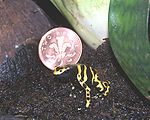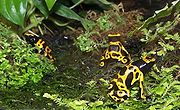
Yellow-banded Poison Dart
Encyclopedia
The Yellow-banded poison dart frog (also known as yellow-headed poison dart frog and bumblebee poison frog), Dendrobates leucomelas, is a poison dart frog
from the Dendrobates genus of the Dendrobatidae family.
. It is also found in parts of Guyana
, Brazil and the extreme eastern most part of Colombia
This amphibian
is normally found in very humid conditions in tropical rain forests, close to fresh water. It is often found on flat rocks, trees, plants (notably, bromeliads) and the leaf litter of the forest floor. During the dry season, specimens are known to congregate in damper places such as under rocks or fallen tree trunks.
The Leucomelas natural habitat is tropical, and not subject to great seasonal temperature variations. Typically, temperature variances are related to elevation and time of day, and range from the low 20s °C to the low 30s °C. In captivity, care must be taken not to overheat the frogs as they can be sensitive to higher temperatures.
Although preferring high humidity levels, this species can handle lower humidity levels much better than other species in the genus. Specimens can also be found in the seasonally drier forest islands in its natural range, and at elevations ranging from sea level, to 800 metres AMSL
.
 Leucomelas is one of the largest species in the genus Dendrobates, with a snout to vent length of between 3.1 centimetres (1.2 in) to 5 centimetres (2 in). Average adult size, however, rarely exceeds 4 centimetres (1.6 in). Their average weight is reported as being around 3 gram (0.00661386786554633 lb). Males tend to be slightly bigger than the females, but otherwise, there is little in their appearance to casually sex the species.
Leucomelas is one of the largest species in the genus Dendrobates, with a snout to vent length of between 3.1 centimetres (1.2 in) to 5 centimetres (2 in). Average adult size, however, rarely exceeds 4 centimetres (1.6 in). Their average weight is reported as being around 3 gram (0.00661386786554633 lb). Males tend to be slightly bigger than the females, but otherwise, there is little in their appearance to casually sex the species.
Like most poison dart frogs, Dendrobates leucomelas has evolved aposematic colouration as a warning to potential predators that they will make an unpalatable or toxic meal.
Predominantly, these frogs have a bright yellow colouration with varying amounts of broad black stripes and/or spots that extend over the whole body. Some morphs are orange in colour, and variations exist within the species (naturally occurring and not morphs solely within the exotic pet community) that dictate the extent of these markings ranging from fine spots to thick unbroken banding.
They have glandular adhesive pads on their toes (which aid in climbing and positioning) and, in common with other species in their order, they have a short, protrudable, unnotched, sticky tongue, which extends to catch prey.
.
prey items. It is uncertain precisely which arthropods lend their toxicity to which genus of Dendrobatidae, but one such arthropod is thought to have been identified as a possible source of the toxin for Dendrobatidae P. terriblis, and it is a local variant of the Melyrid beetle.
Dendrobatidae toxins vary from species to species, but some are extremely potent neurotoxins. The alkaloid toxins, secreted from the frog's skin, interfere with nerve impulses, which can lead to heart failure or fibrillation.
 This species relative ability to withstand broad variations in humidity and temperature, combined with its comparatively bold nature, make it a popular choice for those enthusiasts and amateur herpetologists involved in the exotic pet community. It is widely seen as being an ideal starter species for amateur hepetologists wishing to keep poison dart frogs for the first time.
This species relative ability to withstand broad variations in humidity and temperature, combined with its comparatively bold nature, make it a popular choice for those enthusiasts and amateur herpetologists involved in the exotic pet community. It is widely seen as being an ideal starter species for amateur hepetologists wishing to keep poison dart frogs for the first time.
The species' robustness, relatively common numbers in the wild, and its widespread natural distribution has helped maintain this frogs status of "least Concern"
on the International Union for Conservation of Nature's conservation red list, despite some over harvesting of wild specimens for the exotic pet trade. The species' ability to be easily bred in captivity has led to a fall in prices within the exotic pet trade, which is an alleviative factor to the problem of over harvesting.
Once in captivity and removed from their natural source of food, Dendrobatidae lose much of their toxicity. Dendrobates leucomelas, however, are not one of the three main Dendrobatidae species that are used for poison darts by native South American tribal hunters, so toxicity levels are somewhat lower in wild caught specimens than in the phyllobates genus.
Poison dart frog
Poison dart frog is the common name of a group of frogs in the family Dendrobatidae which are native to Central and South America. These species are diurnal and often have brightly-colored bodies...
from the Dendrobates genus of the Dendrobatidae family.
Distribution and habitat
D. leucomelas is found in the northern part of continent of South America, most notably in VenezuelaVenezuela
Venezuela , officially called the Bolivarian Republic of Venezuela , is a tropical country on the northern coast of South America. It borders Colombia to the west, Guyana to the east, and Brazil to the south...
. It is also found in parts of Guyana
Guyana
Guyana , officially the Co-operative Republic of Guyana, previously the colony of British Guiana, is a sovereign state on the northern coast of South America that is culturally part of the Anglophone Caribbean. Guyana was a former colony of the Dutch and of the British...
, Brazil and the extreme eastern most part of Colombia
Colombia
Colombia, officially the Republic of Colombia , is a unitary constitutional republic comprising thirty-two departments. The country is located in northwestern South America, bordered to the east by Venezuela and Brazil; to the south by Ecuador and Peru; to the north by the Caribbean Sea; to the...
This amphibian
Amphibian
Amphibians , are a class of vertebrate animals including animals such as toads, frogs, caecilians, and salamanders. They are characterized as non-amniote ectothermic tetrapods...
is normally found in very humid conditions in tropical rain forests, close to fresh water. It is often found on flat rocks, trees, plants (notably, bromeliads) and the leaf litter of the forest floor. During the dry season, specimens are known to congregate in damper places such as under rocks or fallen tree trunks.
The Leucomelas natural habitat is tropical, and not subject to great seasonal temperature variations. Typically, temperature variances are related to elevation and time of day, and range from the low 20s °C to the low 30s °C. In captivity, care must be taken not to overheat the frogs as they can be sensitive to higher temperatures.
Although preferring high humidity levels, this species can handle lower humidity levels much better than other species in the genus. Specimens can also be found in the seasonally drier forest islands in its natural range, and at elevations ranging from sea level, to 800 metres AMSL
Above mean sea level
The term above mean sea level refers to the elevation or altitude of any object, relative to the average sea level datum. AMSL is used extensively in radio by engineers to determine the coverage area a station will be able to reach...
.
Morphology

Like most poison dart frogs, Dendrobates leucomelas has evolved aposematic colouration as a warning to potential predators that they will make an unpalatable or toxic meal.
Predominantly, these frogs have a bright yellow colouration with varying amounts of broad black stripes and/or spots that extend over the whole body. Some morphs are orange in colour, and variations exist within the species (naturally occurring and not morphs solely within the exotic pet community) that dictate the extent of these markings ranging from fine spots to thick unbroken banding.
They have glandular adhesive pads on their toes (which aid in climbing and positioning) and, in common with other species in their order, they have a short, protrudable, unnotched, sticky tongue, which extends to catch prey.
Behaviour
D. leucomelas are diurnal by nature, and are known to be fiercely territorial. They live in small groups in the wild and will attack neighbouring groups with surprising ferocity for a creature of their size. They will also warn off rivals by emitting loud calls; D. leucomelas is known to have one of the loudest calls among poison dart frogs; theirs can be heard from some distance and is described as an innocent-sounding, birdlike trill. D. leucomalas, as with all frogs, can also call to attract members of the opposite sex (see the Reproduction section below). Uniquely, it is also the only poison dart frog to estivate during dry spells.Reproduction
Yellow banded poison dart frogs reproduce sexually. The mother lays her fertilized eggs (zygotes) in a body of water. When they hatch, they are called tadpolesTadpoles
Tadpoles are a psychedelic rock band formed in 1990 in New York City by Todd Parker , Michael Kite Audino and Josh Bracken In 1992, Nick Kramer , David Max and Andrew Jackson of the fledgling Manhattan group, Hit, joined the Tadpoles after putting Hit on hiatus.In 1993 Kite and Jackson left the...
.
Toxicity
Like all Dendrobatidae, D. leucomelas secrete toxins from their skin which they gain from eating certain unspecified arthropodArthropod
An arthropod is an invertebrate animal having an exoskeleton , a segmented body, and jointed appendages. Arthropods are members of the phylum Arthropoda , and include the insects, arachnids, crustaceans, and others...
prey items. It is uncertain precisely which arthropods lend their toxicity to which genus of Dendrobatidae, but one such arthropod is thought to have been identified as a possible source of the toxin for Dendrobatidae P. terriblis, and it is a local variant of the Melyrid beetle.
Dendrobatidae toxins vary from species to species, but some are extremely potent neurotoxins. The alkaloid toxins, secreted from the frog's skin, interfere with nerve impulses, which can lead to heart failure or fibrillation.
Husbandry and conservation status

The species' robustness, relatively common numbers in the wild, and its widespread natural distribution has helped maintain this frogs status of "least Concern"
Least Concern
Least Concern is an IUCN category assigned to extant taxon or lower taxa which have been evaluated but do not qualify for any other category. As such they do not qualify as threatened, Near Threatened, or Conservation Dependent...
on the International Union for Conservation of Nature's conservation red list, despite some over harvesting of wild specimens for the exotic pet trade. The species' ability to be easily bred in captivity has led to a fall in prices within the exotic pet trade, which is an alleviative factor to the problem of over harvesting.
Once in captivity and removed from their natural source of food, Dendrobatidae lose much of their toxicity. Dendrobates leucomelas, however, are not one of the three main Dendrobatidae species that are used for poison darts by native South American tribal hunters, so toxicity levels are somewhat lower in wild caught specimens than in the phyllobates genus.
External links
- Dendrobates leucomelas at Amphibiaweb
- Dendrobates leucomelas at CalPhotos

